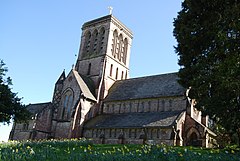Kingston (Corfe Castle)
| Kingston | ||
|---|---|---|
| The new church, St James Church | ||
| Coordinates | 50 ° 37 ′ N , 2 ° 0 ′ W | |
|
|
||
| administration | ||
| Post town | Swanage | |
| ZIP code section | BH19 | |
| prefix | 1929 | |
| Part of the country | England | |
| region | South West England | |
| Ceremonial county | Dorset | |
| Unitary authority | Dorset | |
Kingston is a small village on the Isle of Purbeck peninsula in the county of Dorset in the south of England .
location
Kingston is about two kilometers south of Corfe Castle (town) and Corfe Castle and about eight kilometers west of Swanage . The village of Kingston is surrounded by woodland and is approximately 120 meters above sea level. The village can be seen very well from a distance.
history
The village
The village is remarkable because it has two churches. From the 12th century until 1877, Kingston was a chapel site in the parish of Corfe Castle. The chapel stood on the east side of the village and was served by the Rector of Corfe Castle or his assistant.
The inn dates back to 1787. It was originally called the New Inn . Its name was changed to Eldon Arms in the early 1800s . After the Second World War , the name was changed again and is now called The Scott Arms .
The first school in Kingston was established on September 24, 1786. The school building was erected by their children in 1856 in memory of the late Earl and Countess Eldon. The school house offered space for up to 100 children and had an apartment for the school principal. The old school building is now privately owned and used as a residential building.
The old church
In 1833, John Scott the 1st Earl of Eldon (1751-1838), later Lord Chancellor Eldon, replaced the chapel at his own expense with the Old Church of St. James, which still stands on the site to this day. It was designed by his son-in-law, George Repton. It largely follows the ground plan of the replaced chapel. The church was surrounded by many graves. The first earl and his wife are buried in the cemetery; it was used as a village church until 1912. After the church was replaced, the old church remained in use as a church hall for many years, after which it was unused. Between 1977 and 1979 it was converted into a residential building.
The new church
The other church, St James Church, is quite elaborate. It was built in 1874 and completed in 1880. The builder was John Scott, the 3rd Earl of Eldon (1845-1926), and the architect was the well-known church architect George Edmund Street (1824-1881). St James Church resembles a miniature early English cathedral, and its tower dominates the landscape. The tower is disproportionate to the rest of the church. It is large enough to contain a full ring of eight bells. The bells were built and installed by John Taylor & Co., Loughborough, in 1880. Inside the church, the cluster columns, as well as many other details, are made of Purbeck marble . The Purbeck stone and marble comes from Lord Eldon's Encombe Gut quarry and was processed by his own craftsmen.
The new St James Church did not immediately replace the existing church. It was used as the house chapel of the Eldon family for over forty years. In April 1921 Lord Eldon handed the church and cemetery over to the church commissioners. It was consecrated by Bishop Jocelyne on October 11, 1921. The commissioners replaced the old church with the new church in January 1922.
The chapel
There was also a Wesleyan Chapel at the base of Kingston Hill. It is now a privately owned residential home.
Web links
- Online Parish Clerk (OPC) English

